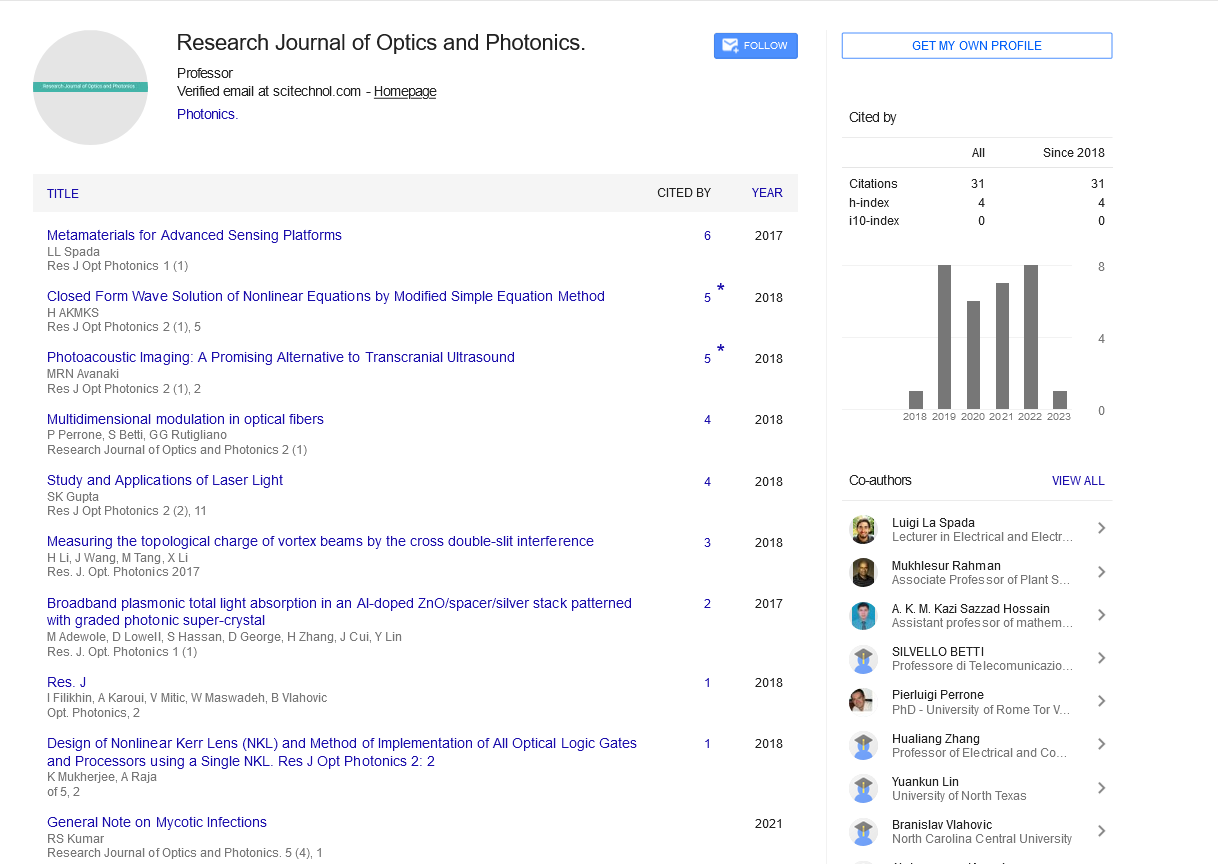Commentary, J Opt Photonics Vol: 7 Issue: 4
Advancements and Applications of Optoelectronics in the Digital Age
Chanik Kang*
1Department of Physics, Hanyang University, Seoul, South Korea
*Corresponding Author: Chanik Kang,
Department of Physics, Hanyang
University, Seoul, South Korea
E-mail: chanik@kang.kr
Received date: 22 November, 2023, Manuscript No. RJOP-24-128320;
Editor assigned date: 24 November, 2023, PreQC No. RJOP-24-128320 (PQ);
Reviewed date: 08 December, 2023, QC No. RJOP-24-128320;
Revised date: 15 December, 2023, Manuscript No RJOP-24-128320 (R);
Published date: 22 December, 2023, DOI: 10.4172/RJOP.23.7.1000056.
Citation: Kang C (2023) Advancements and Applications of Optoelectronics in the Digital Age. Res J Opt Photonics 7:4.
Description
In the digital age, where information is transmitted, processed, and displayed at lightning speed, optoelectronics has emerged as a foundation technology driving innovation across a multitude of industries. Combining the principles of optics and electronics, optoelectronics enables the manipulation and control of light for a wide range of applications, from telecommunications to healthcare, and from energy to entertainment. Advancements in optoelectronics have been propelled by the continuous evolution of semiconductor materials, fabrication techniques, and device architectures. One of the most significant breakthroughs is the development of highperformance Light-Emitting Diodes (LEDs) and Laser Diodes (LDs). LEDs have revolutionized lighting by offering energy-efficient, longlasting illumination solutions for a variety of applications, including residential, commercial, and automotive lighting. Meanwhile, LDs have enabled the rapid growth of fiber optic communication networks, facilitating high-speed data transmission over long distances with minimal signal loss.
The digital age has also witnessed the emergence of novel optoelectronic materials and devices with enhanced functionalities and performance. Quantum dots, for instance, have garnered significant attention due to their unique optical properties, including tunable emission wavelengths and high quantum efficiency. These semiconductor nanocrystals hold promise for applications in displays, lighting, and biomedical imaging, offering improved color purity, brightness, and energy efficiency compared to conventional phosphors and organic dyes. Furthermore, the integration of optoelectronic components into advanced Photonic Integrated Circuits (PICs) has unlocked new possibilities for compact and highly integrated optical systems. PICs combine various optical functions, such as light generation, modulation, amplification, and detection, on a single chip, enabling complex optical signal processing and routing with minimal energy consumption and footprint. These integrated systems are instrumental in the development of next-generation optical communication networks, data centers, and sensing platforms, supporting the ever-increasing demand for high-speed data transmission and processing.
In the field of healthcare, optoelectronics plays a crucial role in medical imaging, diagnostics, and therapy. Optical Coherence Tomography (OCT), for example, utilizes low-coherence interferometry to generate high-resolution, cross-sectional images of biological tissues, enabling non-invasive visualization of anatomical structures and pathological changes. OCT has become an indispensable tool in ophthalmology for diagnosing retinal diseases and monitoring treatment outcomes, as well as in cardiology, dermatology, and gastroenterology for various clinical applications. Moreover, optoelectronic biosensors offer sensitive and selective detection of biomolecules for medical diagnostics, environmental monitoring, and food safety. These biosensors utilize optical transduction mechanisms, such as Surface Plasmon Resonance (SPR), fluorescence, and photonic crystal resonances, to detect the binding events between target analytes and recognition elements immobilized on sensor surfaces. By using the specificity of biomolecular interactions and the sensitivity of optical detection, optoelectronic biosensors enable rapid and reliable detection of disease markers, pathogens, and toxins with minimal sample preparation and reagent consumption.
In the energy sector, optoelectronics plays a crucial role in the development of renewable energy technologies, such as solar Photovoltaics (PV) and solid-state lighting. Photovoltaic devices based on semiconductor materials, such as silicon, cadmium telluride, and perovskites, convert sunlight directly into electricity, offering a clean and sustainable alternative to fossil fuels. Recent advancements in PV technology, including tandem solar cells, thin-film and flexible PV modules, and perovskite-silicon hybrid structures, have significantly improved the efficiency, cost-effectiveness, and scalability of solar energy conversion.
Furthermore, solid-state lighting technologies, offer energyefficient and environmentally friendly alternatives to traditional incandescent and fluorescent lighting. These light sources provide superior brightness, color quality, and controllability, enabling innovative lighting designs and applications in residential, commercial, and automotive sectors. From high-speed communication networks to precision medical diagnostics and from renewable energy technologies to immersive displays, the applications of optoelectronics are vast and far-reaching. As researchers and engineers continue to do research the boundaries of what is possible, the future of optoelectronics holds boundless opportunities for exploration and discovery, promising to shape the technological landscape for generations to come.
 Spanish
Spanish  Chinese
Chinese  Russian
Russian  German
German  French
French  Japanese
Japanese  Portuguese
Portuguese  Hindi
Hindi 